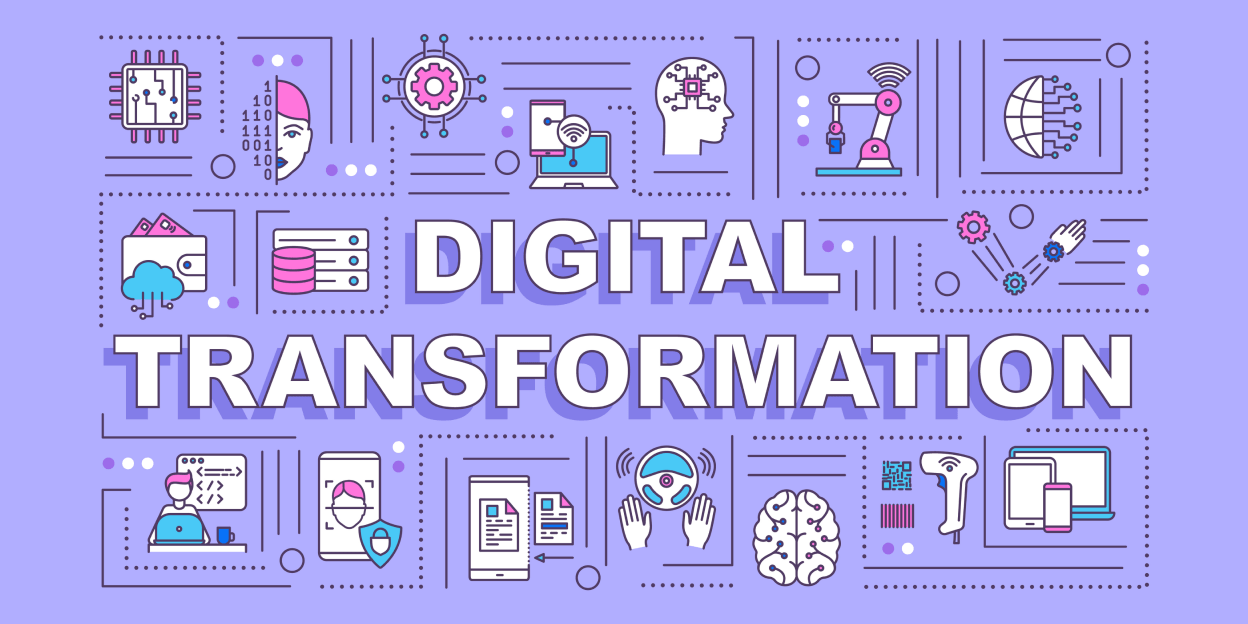The world around us is changing rapidly, and digital is at the heart of this revolution. Our business landscape is becoming increasingly digital, creating not just new opportunities but also presents unique challenges.
Businesses, whether small or large, are feeling the need to adapt and evolve in this digital era. Here at Feefo, we believe that with a bit of guidance, you too can embrace these changes and harness the power of digital to transform your business.
In this guide, we'll be your partners in understanding what digital transformation means, its importance, and why it matters to you. We'll bring you expert insights, clear explanations, and relatable examples that demonstrate the impact of digital transformation across various areas of business.
What is digital transformation?
Digital transformation is a strategic, wholesale change to the way businesses operate and deliver value to customers that holds powerful implications for businesses of all sizes and industries. It involves using digital technologies to transform services or businesses by replacing non-digital or manual processes with digital processes or replacing older digital technology with newer digital technology.
The transformation goes beyond technology, however. It impacts how you structure and manage your organisation, how you engage with your customers, and even your business's culture. It's about creating new — or modifying existing — business processes, culture, and customer experiences to meet changing business and market requirements.
For instance, digital transformation could mean using predictive analysis to make smarter business decisions, implementing automation to streamline operations, using digital platforms to reach a wider audience, or even changing your business model to provide services online.
The specifics of digital transformation vary widely based on an organisation's specific challenges and demands. But with a solid strategy, it can lead to a significant competitive advantage.
Digital transformation examples
There are five major areas where digital transformation happens:
- Customer experience: How you interact with your customers, how you sell to them, and how you service them.
- Operational agility: The processes and workflows that happen behind the scenes to make your business run smoothly.
- Culture and leadership: How your company handles change and innovation, and how your leadership drives digital initiatives.
- Workforce enablement: The technology and tools your employees use to do their jobs more efficiently.
- Digital technology integration: The integration of new technology into various areas of your business to drive growth.
Why digital transformation is important
Digital transformation isn't just a nice-to-have, but a need-to-have. With a world that's rapidly embracing digital technologies, digital transformation is about paving the way towards a more efficient, innovative, and customer-centric future.
Customer focused
First off, digital transformation enhances your ability to serve your customers. In today's connected world, customers are looking for a seamless and personalised experience. By harnessing digital tools, you can anticipate your customers' needs, tailor their experiences, and interact with them on their terms. Simply put, digital transformation allows you to put your customers at the heart of your business — where they truly belong.
Smoother operations
Secondly, digital transformation brings about improved operational efficiency. By automating manual processes and utilising data-driven insights, you can make your business leaner, faster, and more cost-effective. Think less time on paperwork and more time on strategic tasks. Less guessing, more knowing.
Develop creativity
Then there's the aspect of fostering innovation. Digital transformation creates an environment that encourages experimentation and embraces failure as a stepping stone towards success. It can spur creativity, unlock new business models, and open up exciting opportunities that would've been unthinkable a few years ago.
Moreover, digital transformation is about future-proofing your business. The digital world is here to stay, and by embarking on this journey, you're not just reacting to changes but proactively shaping your business to thrive in this new landscape.
What drives digital transformation?
Understanding what drives digital transformation can help you better position your business to take full advantage of it.
- Customer expectations — Today's consumers are tech-savvy and expect seamless, digital interactions with the businesses they engage with. They desire personalized experiences, easy access to information, and quick, efficient service. To meet these growing demands, businesses need to integrate digital technologies that enhance customer experiences.
- Technology — As advancements in areas like artificial intelligence, machine learning, data analytics, cloud computing, and blockchain continue to evolve, they create new opportunities for businesses to innovate and improve. Technology isn't just changing the game; it's changing the entire playing field!
- Improved efficiency — Automation of manual tasks, real-time data analysis, and collaborative digital workspaces can streamline operations, improve decision making, and ultimately lead to a more efficient, effective organization.
- Staying competitive — As more and more businesses undergo digital transformations, those that don't risk falling behind. In today's fast-paced business environment, the ability to adapt quickly to changes can mean the difference between leading the market or playing catch up.
- Business resilience — As we've seen in recent years, unexpected events can drastically affect businesses. Having a robust digital infrastructure allows businesses to quickly adapt and respond to such disruptions, ensuring continuity and resilience.
Areas of digital transformation
- Customer Experience — At the core of any business is its customers. Digital transformation helps you refine the customer journey with personalised interactions, multi-channel accessibility, and quick responses. By leveraging technologies like CRM systems, social media, and mobile apps, you can create seamless experiences that make your customers feel truly valued.
- Business Operations — This is about the heart of your business — the processes that keep the wheels turning. Digital transformation can streamline your operations, making them more efficient and effective. Through automation and integration of systems, tasks that once took hours can be accomplished in minutes.
- Products and Services — Digital transformation opens doors to innovate your products or services. For instance, a restaurant might offer an online ordering system, or a retailer might use augmented reality to allow customers to 'try' products virtually.
- Decision Making — Data-driven decision-making is a key aspect of digital transformation. Tools that collect and analyse data can provide valuable insights about your business and your market. These insights can guide strategic decisions, leading to better outcomes and increased competitiveness.
- Culture and Leadership — It’s not just about tech and tools but also about the people steering the ship. Leaders need to foster a culture that encourages continuous learning and agility, and embraces change. Remember, a digital mindset is just as important as digital tools!
- Cybersecurity — As businesses become more digital, they also become more vulnerable to cyber threats. Cybersecurity measures are, therefore, a critical part of digital transformation. Implementing robust security systems will protect your business and build trust with your customers.

How to get started with digital transformation
There’s never been a better time to take a radical look at your business and ask yourself if you’re truly serving your customers. Here are four things you should do to begin your digital transformation process.
1. Maintain a human connection
People always remember the way you made them feel. The human connection you have with your customers is the most important consideration. Whether you’re speaking to someone in-store or replying to a complaint on Twitter, every area of your business needs to put the customer first.
But how can you maintain that connection when almost every touchpoint you have with your customers is virtual? Collecting feedback at every stage of your customer journey will not only maintain a level of contact with your customers, but it will also give you insight into where your connection with your customers is strongest and where it’s weakest.
Make sure you respond to, and follow up on, any feedback you receive, too. This will show that you’re listening and taking what they say seriously – whether they’ve been positive or negative about your business.
2. Collect a range of feedback and act on it
From customer surveys to feedback straight from your customer service team, make sure you’re listening to a range of sources and making the most of that feedback. Here are some of the most important types of feedback and how they can be used to improve your business and its processes.
Product and service reviews — Are your products as good as you think they are, or are customers running into issues time and again? How could your service be improved to ensure your customers remain loyal? Product and service reviews are perfect for measuring whether you’re meeting customers’ expectations or not, as well as building trust in your business.
Reviews can be collected throughout the customer journey. For example, if you’re a travel business, you may want to collect feedback when the customer makes a booking, after their outbound flight, and once they’re back home from their trip. This is vital to get a complete view of each customer's experience with you, as you can understand exactly how they feel at each stage and identify any pain points easily.
Surveys — Is it easy for visitors to find what they’re looking for on your website? Is your customer service team great at solving issues over live chat? Surveys are a great way to measure the smaller, but still important, parts of the customer journey. You can ask for feedback on almost anything and engage with a much wider audience, allowing you to understand everything from how your brand is perceived by non-customers to why someone chose to go with a competitor instead of you.
For example, if you want to learn more about what visitors think of your website, you can create a survey and put the link in a pop-up asking visitors for feedback.
Social listening — Gathering feedback through surveys and reviews allows you to ask specific questions, which is helpful when you want to know what people think about a specific interaction or product, but your customers may have slightly more to say that they wouldn’t feel comfortable sharing with your one on one.
Social listening tools allow you to be a fly on the wall – you can see what people are saying about your brand online, unfiltered. If people hate your new advert, they may not get in touch with you directly, but they could tweet about it. By catching these criticisms early, you can act fast and solve these issues before they snowball into a huge PR problem.
It’s not all about the negatives, though. What do people love about your brand that they aren’t telling you about? Maybe it’s your sustainability practices or the fact you offer something no one else does. By knowing what makes you special, you can realign your marketing focus and craft better campaigns.
Not all the information you get through reading Facebook comments or forum posts will be helpful, but they do allow you to see how your brand is perceived online.
3. Align your digital and physical engagements
If you’re lucky enough to have a store or a chain of stores, don’t treat them as separate from your online offering.
Whether your customers choose to buy from you online or visit you in-store, you must deliver a seamless experience. Your branding, messaging, and tone of voice should all be consistent across your offline and online functions. For example, if customers come to your store because they know they’re going to get a personal service, you could offer this online by running a live chat or consultation service that allows your customers to contact a member of staff for help if they can’t visit you in person.
4. Be agile
Rigid processes are the downfall of digital transformation. Every department needs to have the flexibility to adapt to changing situations and customer needs. As Covid-19 has shown, those needs could change overnight, and your business may need to adjust its processes very quickly so that your customers experience minimal disruption.
Giving your teams the right tools to allow them to be agile is important, but you must make sure they have the right skills too. Invest in training and regularly run refresher sessions so they know how to get the most out of the tools at their disposal. You can even run some internal surveys to see where your various departments need more help or support.
Embracing digital transformation with Feefo
Digital transformation is not just a buzzword; it's an essential journey that businesses must embark on to remain relevant, competitive, and efficient in the modern digital era. This journey is about leveraging technology to create value, enhance customer experiences, and empower your business to thrive amidst change.
Our feedback and insight tools can help you stay on top of customer trends and track what your customers think and how they feel.
Get in touch with our friendly team today to see how we can help you truly understand your customers.



